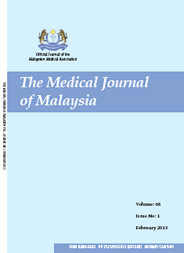MJM, Vol 70 Supplement 1 September 2015
Prevalence of asthma and level of fractional
exhaled nitric oxide (FeNO) among school children in Terengganu, Malaysia
*Jabatan Kesihatan Masyarakat, Pusat Perubatan Universiti Kebangsaan Malaysia, Kuala Lumpur, **United Nations University International Institute for Global Health (UNU-IIGH), Kuala Lumpur, ***Uppsala University, Uppsala, Sweden, ****Universiti Putra Malaysia, Serdang, Selangor
ABSTRACT
Introduction: Classrooms remain one of the commonest places where air pollution exposure can occurs. The use of fractional exhaled nitric oxide (FeNO) measurements has been increasingly accepted in clinical practice based on a number of theoretical and practical factors. It is not only a user friendly, portable and non-invasive biomarker, but is also able to detect early inflammatory airway changes. The aim of this study is to measure the level of FeNO across gender, pollutant exposure and asthma status among 14 years old children in Terengganu, Malaysia.
Methods: The study population was randomly selected from secondary schools. A questionnaire with standardised questions was used to obtained knowledge on their living conditions, school environment, asthmatic symptoms and allergy status. FeNO measurements and skin prick tests were conducted.
Results: From 487 students, only 365 students had consent from their parents for medical examinations. Majority (99%) was Malays, female (62%) and non- smoker (97%). The prevalence of asthma was 11.1%, of which 31.5% were on medication. Male student (median 18ppb, IQR 19) had substantially higher FeNO levels than female (median 14ppb, IQR 13). Allergic to Dermatophagoides Pteronysinus (OR=1.37, 95% CI: 1.22-1.54), allergic to Alternaria alternate (OR= 2.76, 95% CI: 1.18-6.46) and exposure to higher dust weight (OR= 1.65, 95% CI: 1.03-2.62) was associated with higher levels of FENO among the school children.
Conclusion: The problem of multiple confounding factors and overlap between healthy and asthmatic populations preclude obtaining the FeNO reference values for clinical practice. However, it opens further research interests for better assessment of asthma among Malaysian children.
Keywords: FENO, Asthma, school children, Terengganu, Malay.
